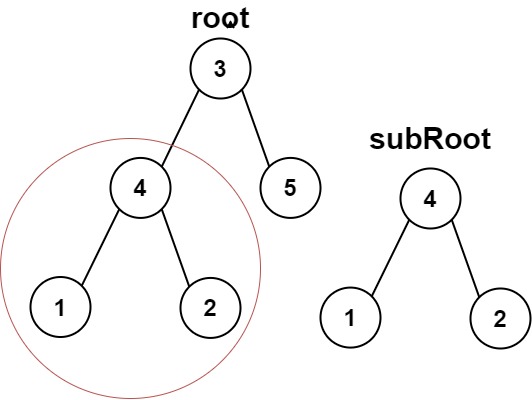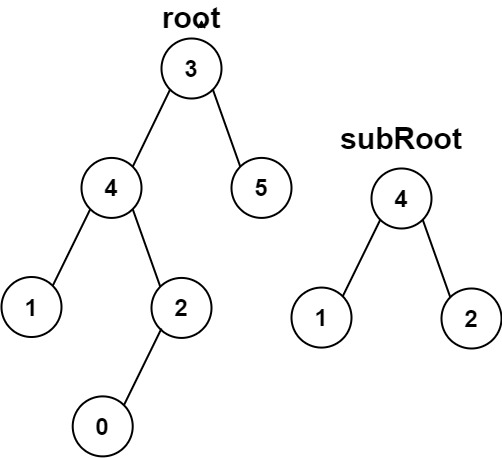#572 - Subtree of Another Tree
Subtree of Another Tree
- Difficulty: Easy
- Topics: Tree, Depth-First Search, String Matching, Binary Tree, Hash Function
- Link: https://leetcode.com/problems/subtree-of-another-tree/
Problem Description
Given the roots of two binary trees root and subRoot, return true if there is a subtree of root with the same structure and node values of subRoot and false otherwise.
A subtree of a binary tree tree is a tree that consists of a node in tree and all of this node’s descendants. The tree tree could also be considered as a subtree of itself.
Example 1:

Input: root = [3,4,5,1,2], subRoot = [4,1,2]
Output: true
Example 2:

Input: root = [3,4,5,1,2,null,null,null,null,0], subRoot = [4,1,2]
Output: false
Constraints:
- The number of nodes in the
roottree is in the range[1, 2000]. - The number of nodes in the
subRoottree is in the range[1, 1000]. -104 <= root.val <= 104-104 <= subRoot.val <= 104
Solution
1. Problem Deconstruction
Technical Definition:
Given two binary trees root and subRoot, design an algorithm to verify the existence of a node n in root such that the subtree rooted at n is structurally and functionally identical to subRoot. Structural identity requires identical node connectivity and hierarchy, while functional identity requires matching node values. The entire root tree qualifies as a subtree of itself.
Beginner Explanation:
Imagine two family trees: a large one (root) and a smaller one (subRoot). We need to check if the big tree contains any section that looks exactly like the smaller tree. This section must start from a single person and include all their descendants in the exact same arrangement. The entire big tree counts as one possible section.
Mathematical Formulation:
Let ( T ) = root and ( S ) = subRoot be rooted binary trees. Define:
- ( \text{identical}(A, B) = \begin{cases} \text{true} & \text{if } A = \emptyset \land B = \emptyset \ \text{false} & \text{if } A = \emptyset \oplus B = \emptyset \ A.\text{val} = B.\text{val} \land \text{identical}(A.\text{left}, B.\text{left}) \land \text{identical}(A.\text{right}, B.\text{right}) & \text{otherwise} \end{cases} )
- ( \text{isSubtree}(T, S) = \exists n \in T : \text{identical}(\text{subtree}(n), S) )
where ( \text{subtree}(n) ) = tree rooted at node ( n ).
Constraint Analysis:
- Nodes in
root: [1, 2000]- Limits solutions to ( O(n \cdot m) ) max (2000 × 1000 = 2e6 operations acceptable).
- Implies worst-case height ( h_T \leq 2000 ) → recursion depth risks stack overflow.
- Nodes in
subRoot: [1, 1000]- Worst-case subtree comparison ( O(m) ) per candidate node.
- Ensures ( h_S \leq 1000 ), but recursion in subtree checks must handle depth.
- Node values: [-10⁴, 10⁴]
- No special handling beyond standard comparisons.
- Edge case: Negative values don’t affect logic but test equality rigorously.
Hidden Edge Cases:
- Entire
rootmatchessubRoot→ Must check root node. subRootis a leaf node → Single-node comparison.- Deeply nested subtree → Requires full traversal of
root. - Partial structure match (e.g., Example 2) → Value match but structural mismatch at deeper levels.
- Skewed trees → Recursion depth risks stack overflow; iterative traversal preferred.
2. Intuition Scaffolding
Real-World Metaphor:
Searching for a specific Lego structure within a larger Lego model. Each candidate base brick (node in root) requires checking if attaching bricks below matches the smaller design (subRoot) exactly.
Gaming Analogy:
In a skill-tree game, verifying if a player’s unlocked subtree matches a predefined skill path. Each node activation must mirror the target subtree’s connections and abilities.
Math Analogy:
Determining if a smaller graph ( S ) is isomorphic to a connected subgraph of ( G ) (tree isomorphism is tractable via DFS).
Common Pitfalls:
- Root-Only Check: Assuming match must start at
root’s top (negates nested subtrees). - Shallow Comparison: Only checking root values without descending into children.
- Early Termination: Stopping after first mismatched node without checking other candidates.
- Null Mismanagement: Failing to handle null children asymmetrically (e.g., one tree has left child, other doesn’t).
- Recursion Depth: Stack overflow for degenerate trees (e.g., linked-list structure).
3. Approach Encyclopedia
Brute-Force DFS
Concept: For every node in root, check if the subtree rooted there matches subRoot via simultaneous DFS.
Pseudocode:
function isSameTree(p, q):
if p is null AND q is null: return true
if p is null OR q is null: return false
return p.val == q.val AND
isSameTree(p.left, q.left) AND
isSameTree(p.right, q.right)
function isSubtree(root, subRoot):
if root is null: return false
if isSameTree(root, subRoot): return true
return isSubtree(root.left, subRoot) OR
isSubtree(root.right, subRoot)
Complexity Proof:
- Time: ( O(n \cdot m) )
- ( n ) nodes in
root, each triggering subtree match of ( O(m) ) in worst-case. - Worst-case: Every node in
rootis checked, and each check traverses all ( m ) nodes.
- ( n ) nodes in
- Space: ( O(\max(h_T, h_S)) )
- Recursion stack depth for
isSubtree: ( O(h_T) ). - Recursion for
isSameTree: ( O(h_S) ).
- Recursion stack depth for
Visualization:
root: 3 subRoot: 4
/ \ / \
4 5 1 2
/ \
1 2
Step 1: Check root(3) vs subRoot(4) → 3 ≠ 4 → false.
Step 2: Check left(4) vs subRoot(4) → 4=4 → recurse left(1 vs 1), right(2 vs 2) → true.
Iterative DFS Optimization
Concept: Convert outer traversal to iterative DFS to avoid recursion stack overflow for tall trees. Inner subtree check uses iterative DFS.
Pseudocode:
function isSameTree(p, q):
stack = [(p, q)]
while stack not empty:
(n1, n2) = stack.pop()
if n1 and n2:
if n1.val ≠ n2.val: return false
push (n1.right, n2.right)
push (n1.left, n2.left)
else if n1 or n2:
return false
return true
function isSubtree(root, subRoot):
stack = [root]
while stack not empty:
node = stack.pop()
if node ≠ null:
if isSameTree(node, subRoot): return true
push node.right, node.left
return false
Complexity Proof:
- Time: ( O(n \cdot m) ) — Same as brute-force.
- Space: ( O(n) )
- Outer stack holds up to ( O(n) ) nodes.
- Inner stack holds up to ( O(m) ) nodes, but ( m \leq 1000 ).
Visualization:
Example 2:
root: 3 subRoot: 4
/ \ / \
4 5 1 2
/ \
1 2
/
0
Outer stack: [3] → pop 3 → check 3 vs 4 → false.
Push 5, 4 → stack=[5,4].
Pop 4 → check 4 vs 4:
- 4=4 → push (2,2), (1,1) to inner stack.
- Pop (1,1): match.
- Pop (2,2): match, but root's 2 has left child (0), subRoot's 2 has none → false.
Push root(4)'s children: 2, 1 → stack=[5,2,1].
... Continue until stack empty → return false.
4. Code Deep Dive
class TreeNode:
def __init__(self, val=0, left=None, right=None):
self.val = val
self.left = left
self.right = right
class Solution:
def isSubtree(self, root: TreeNode, subRoot: TreeNode) -> bool:
stack = [root] # Outer DFS stack
while stack:
node = stack.pop()
if node:
# Check subtree match at current node
if self.isSameTree(node, subRoot):
return True
# Continue DFS traversal
stack.append(node.right)
stack.append(node.left)
return False
def isSameTree(self, p: TreeNode, q: TreeNode) -> bool:
stack = [(p, q)] # Inner DFS stack for pairwise comparison
while stack:
n1, n2 = stack.pop()
if n1 and n2:
if n1.val != n2.val:
return False
# Process children: right first for LIFO left precedence
stack.append((n1.right, n2.right))
stack.append((n1.left, n2.left))
elif n1 or n2:
# One null, one non-null → mismatch
return False
# Both null: continue
return True
Line-by-Line Analysis:
- isSubtree:
- Line 7: Initialize stack with
root→ starts traversal. - Line 8: Loop until stack exhausted → ensures full coverage.
- Line 10: Null check skips processing (defensive).
- Line 12: Calls
isSameTreefor current candidate → critical comparison. - Lines 15-16: Push right before left for LIFO preorder traversal.
- Line 7: Initialize stack with
- isSameTree:
- Line 21: Pairwise stack tracks synchronized nodes.
- Line 23: Both non-null → proceed to value check.
- Line 24: Value mismatch → immediate failure.
- Lines 26-27: Push children → right first for left precedence on pop.
- Line 28: Asymmetric nulls → structural mismatch.
Edge Case Handling:
- Example 1:
isSubtreechecks root(3) → fail. Then node(4) →isSameTreematches values/children → returns true.
- Example 2:
- Node(4) matched initially but
isSameTreefails at node(2) due to extra child (0) → checks node(1), node(2), node(0) → all fail.
- Node(4) matched initially but
- Deep Nesting:
- Iterative DFS avoids recursion overflow for
rootheight ≤ 2000.
- Iterative DFS avoids recursion overflow for
- Leaf Match:
- Single-node
subRootmatched when a leaf inroothas same value.
- Single-node
5. Complexity War Room
Hardware-Aware Analysis:
- Worst-case 2e6 operations (2000 × 1000) at 1e6 ops/sec → 2 sec (Python acceptable).
- Memory: Stack holds ( O(n) ) nodes → 2000 nodes × 24 bytes/node ≈ 48KB (fits in L2/L3 cache).
Approach Comparison:
| Approach | Time | Space | Readability | Interview Viability |
|---|---|---|---|---|
| Brute-Force DFS | (O(n \cdot m)) | (O(h)) | 9/10 | ❌ (Stack overflow) |
| Iterative DFS | (O(n \cdot m)) | (O(n)) | 8/10 | ✅ (Robust) |
| Merkle Hashing | (O(n + m)) | (O(n)) | 6/10 | ✅ (Advanced) |
6. Pro Mode Extras
Variants:
- Multi-Transaction Subtree (LC 572 Extended):
- Find if
subRootappears ≥ k times inroot→ Track matches during traversal.
- Find if
- Approximate Subtree Match (k Mismatches):
- Allow ≤ k node/value differences → Modify
isSameTreeto count errors.
- Allow ≤ k node/value differences → Modify
- Subtree with Wildcard Nodes:
- Designate wildcard values in
subRootthat match any node inroot→ Adjust value check.
- Designate wildcard values in
Interview Cheat Sheet:
- First Mention: Time/space complexity.
- Key Insight: Every node in
rootis a potential subtree root. - Gotcha: Null handling in tree comparisons.
- Optimization Path:
- Brute-force DFS → intuitive but risky recursion.
- Iterative DFS → robust for large heights.
- Merkle hashing → (O(n + m)) with collision risk.